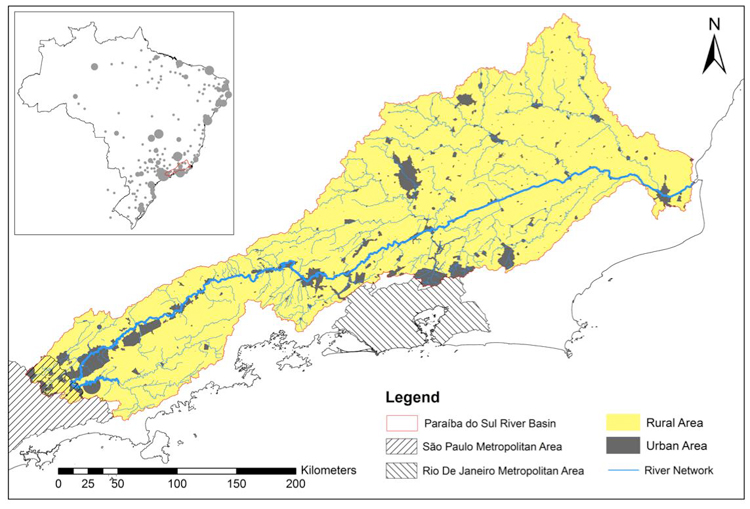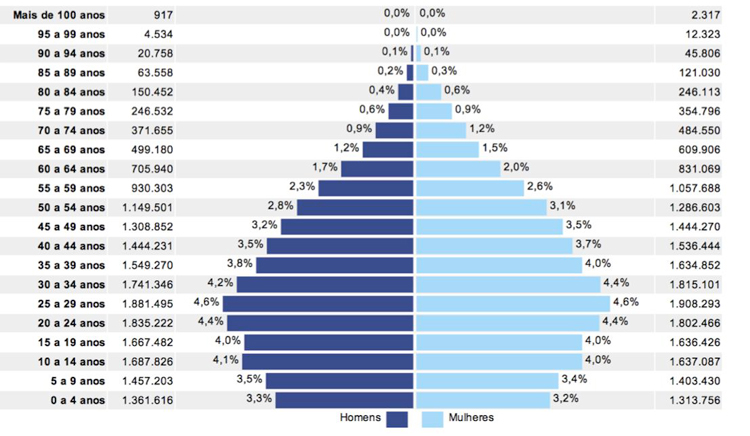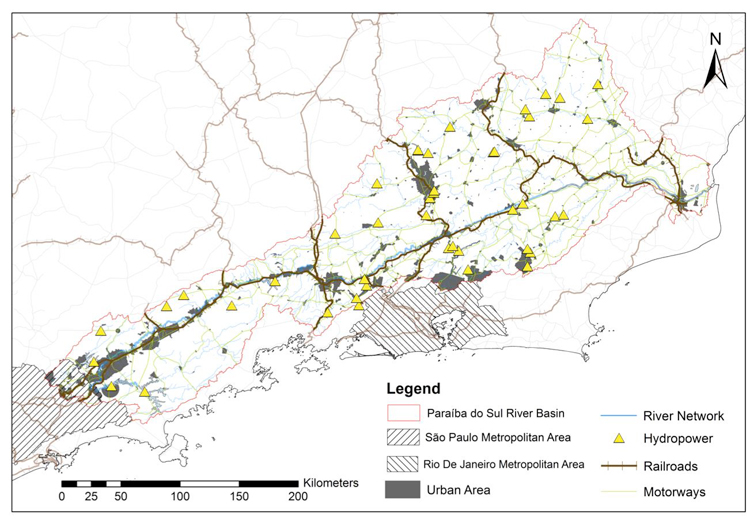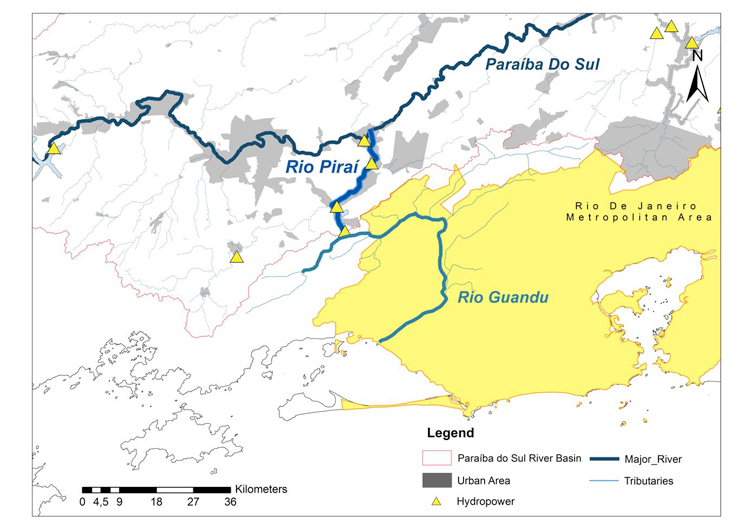Paraíba do Sul (Brazil)
Socioeconomic Development
Demography
In 2005, the total population of the PDS basin was estimated at 5.260.000 inhabitants (AGEVAP, 2006). The greatest fraction lives in the state of Rio de Janeiro. For the forthcoming years, recent estimations predict a continuous population increase (AGEVAP, 2006).
Due to the spreading of industrial activities since 1940, the population distribution changed from predominantly rural to an urban. At present, more than 95 per cent of the inhabitants live in urban agglomerations (AGEVAP, 2011). Table 3 provides a list of all municipalities, respectively urban areas, with more than 20.000 inhabitants. There is no metropolitan area with an absolute surplus meaning inside the basin. However, urban agglomerations are rich in numbers. There are around 40 agglomerations with 20.000 to 200.000 inhabitants.
Within the last 40 years, Brazil has undergone a massive demographic transition as a result of the development from a pre-industrialized to an industrialized society. Even though the population is still increasing, total fertility rates have fallen from almost six to below replacement level (Amaral et al., 2013). Consequently, the shape of the age pyramid changes from a pyramid shape towards a vase shape. This notion is also applicable for the PDS basin. Exemplarily the age pyramid for the state of Rio de Janeiro is shown in the second figure.


Table: Municipalities with more than 20,000 inhabitants (Metzke, 2014).
|
São Paulo |
Rio de Janeiro | Minas Gerais | |||
| S. José dos Campos | 538 909 | C. dos Goytacazes | 406 511 | Juiz de Fora | 456 432 |
| Taubaté | 244 107 | Üetrópolis | 286 348 | Muriaé | 91 525 |
| Jacareí | 191 358 | Volta Redonda | 242 046 | Ubá | 85 001 |
| Pindamonhangaba | 125 722 | Nova Friburgo | 173 321 | Cataguases | 63 960 |
| Guaratinguetá | 104 022 | Barra Mansa | 170 593 | Leopoldina | 50 042 |
| Lorena | 77 843 | Teresópolis | 138 019 | Santos Dumont | 46 775 |
| Caçapava | 75 813 | Resende | 104 482 | Além Paraíba | 33 698 |
| Cruzeiro | 73 469 | Barra do Piraí | 88 475 | Visc. Do Rio Branco | 32 576 |
| Aparencida | 34 834 | Itaperuna | 86 687 | Carangola | 31 920 |
| Tremembé | 34 807 | Três Rios | 71 962 | S. J. Nepomuceno | 23 783 |
| Cachoeira Paulista | 27 201 | Valença | 66 290 | ||
| Cunha | 23 062 | S. Franc. De Itabapoana | 41 046 | ||
| S. Antônio de Pádua | 38 774 | ||||
| Paraíba do Sul | 37 376 | ||||
| São Fidélis | 36 744 | ||||
| Vassouras | 31 402 | ||||
| São João da Barra | 27 503 | ||||
| Miracema | 27 042 | ||||
| Itatiala | 24 729 | ||||
| Paty do Alferes | 25 565 | ||||
| Miguel Pereira | 23 889 | ||||
| Itaocara | 22 999 | ||||
| Bom Jardim | 22 634 | ||||
| Pirai | 22 079 | ||||
| Total | 1 550 697 | 2 216 516 | 915 615 | ||
Human Development Indicators
Life expectancy is a commonly used indicator to measure human health. Over the last 50 years, the life expectancy of Brazilian citizens has risen from 55 years to 73 years (World Bank, 2014). Hospital morbidity data are used to determine the health situation within the PDS (AGEVAP, 2006). Studies reveal that higher records of diseases are found in the north of the basin due to poor sanitation, a lack of sufficient infrastructure as well as low-income levels. Extremes are also found in cities with heavy metal industries.
The total adult literacy rate in Brazil is accounted for around 90 per cent, whereas the literacy rate among youngster (age 15 to 24) is deemed to be even higher at around 97 per cent (UNICEF, 2013). In 1980, the mean year of schooling was not higher than 2.6 years (UNDP, 2013). In 2012, the mean year of schooling already reached 7.2 years. However, due to the low level of school enrolment in previous years, around 50 per cent of citizens above age 25 are unschooled or did not finish primary school (IBGE, 2010).
The income from pasture areas in the PDS has suffered a significant downturn due to environmental degradation (AGEVAP, 2006). In the middle Paraíba region, industries as well as the commerce and service sectors are among the largest income sources for the urban population (Freitas et al., 2007). A general loss of formal jobs and income concentration has been identified at the end of the last century (Freitas et al., 2007). Around 19 per cent of the labour forces were below the poverty line.
Economic Sector and Activities
The PDS river basin is considered to account for an estimated 11 per cent of the gross domestic product (GDP) of Brazil (Ioris, 2008). It has been a key economic region for hundreds of year. At present, the basin is traversed by approximately 9700 industrial and agricultural businesses. The basin hosts a large amount of businesses for metals (Nova Friburgo, São Jose dos Campos, Barra Mansa, Volta Redonda), textiles (Petropolis, Juiz de Fora, Muriaé) and food and drinks (São José dos Campos, Juiz de For a, Petrópolis, Campos) (AGEVAP, 2006). Agricultural businesses are of equal importance in all of the three states. Mixed crop production and livestock farming have by far the highest shares. Other than this, the service sector is of great importance within urban areas (AGEVAP, 2006).
Table: Quantity and Type of Industry (Metzke, 2014)
| Type of Business | Quantity of Business |
|
|
| São Paulo | Rio de Janeiro | Minas Gerais | |
| Industry | |||
| Metals | 201 | 296 | 138 |
| Chemicals | 145 | 0 | 0 |
| Food and Drinks | 321 | 641 | 375 |
| Non-metalic Minerals | 55 | 316 | 69 |
| Textiles | 133 | 713 | 876 |
| Wood and Furniture | 68 | 249 | 144 |
| Rubber, Tobacco and Leather | 52 | 99 | 43 |
| Paper and Graphic | 0 | 193 | 160 |
| Mining | 101 | 65 | 30 |
| Transport Materials | 0 | 40 | 18 |
| Mechanics | 0 | 26 | 26 |
| Footwear | 0 | 0 | 36 |
|
Agriculture |
|||
| Mixed Production | 1 244 | 891 | 1 248 |
| Livestock | 506 | 799 | 307 |
| Horticulture and Seedlings | 61 | 82 | 14 |
| Production, Temporary Crops | 63 | 147 | 45 |
| Activities related to Agriculture | 0 | 331 | 280 |
Hard Infrastructures
Wray (2013) defines hard infrastructures as “underlying foundation of the system of public works for core services such as water management, energy, transportation and information technology”. Due to its vast economical importance and urban penetration, the basin is characterized by an enlarged transportation, energy and water infrastructure.
At present, the basin is traversed by a variety of highways and railways. The construction of the railway network already began in the early 19th century, due to the expansion of coffee plantations (Freitas, 2007). The construction of the extensive highway network is most probably a result of the massive industrialization, which set in in 1940 (Freitas, 2007).
The flow of surface water through the basin is extensively regulated due to the presence of more than 120 hydropower stations (Ioris, 2008). The largest dams and their strategic location to large urban areas are displayed in the figure below. Hydropower plants have an important function in providing energy to the urban and industrialized areas. In 2013, the Simplício Hydroelectric Complex, one of Brazils most ambitious hydropower projects, started its operation. A 24 kilometres long system of channels, tunnels, dams and reservoirs is supposed to raise energy production for urban areas and prevent floods (Hydroworld, 2013).
The diversion of water from the PDS basin plays a vital role for Brazils economic centres. Two thirds of the water is diverted outside the river basin, which supplies 85 per cent of the Metropolitan Area of Rio de Janeiro (Kumler, 2005; Kumler & Lemos, 2008). The diversion complex is illustrated in the second figure.


References and further reading:
AGEVAP (2006) Associação Pró-Gestão das Águas da Bacia Hidrográfica do Rio Paraíba do Sul. Plano de Recursos Hídricos da Bacia do Rio Paraíba do Sul – Resumo, http://www.ceivap.org.br/downloads/PSR-010-R0.pdf, accessed: 02.12.2014.
AGEVAP (2011) Associação Pró-Gestão das Águas da Bacia Hidrográfica do Rio Paraíba do Sul. Relatório Técnico. Bacia do Rio Paraíba do Sul. Subsídos às Acões de Melhoria da Gestão, http://www.agevap.org.br/downloads/Relatorio%20Geral%20versao%20para%20site%2029dez11.pdf, accessed: 30.11.2014.
Amaral, E. F. L., Potter, J. E., Hamermesh, D. S., Rios-Neto, E. L. G. (2013) Demographic Research. Age, education, and earnings in the course of Brazilian development: Does composition matter? http://www.demographic-research.org/volumes/vol28/20/28-20.pdf, accessed: 04.12.2014.
Freitas, C. M.; Schütz, G. E.; De Oliveira, S. G. (2007) Environmental sustainability and human well-being indicators from the ecosystem perspective in the Middle Paraíba Region, Rio de Janeiro State, Brazil, http://www.scielo.br/scielo.php?script=sci_arttext&pid=S0102-311X2007001600012, accessed: 01.12.2014.
IBGE (2010) Censo Demográfico 2010, http://www.ibge.gov.br/home/presidencia/noticias/imprensa/ppts/00000011363712202012375418902674.pdf, accessed: 04.12.2014.
Ioris (2008) The limits of integrated water resources management: a case study of Brazils Paraba do Sul River Basin, http://sspp.proquest.com/archives/vol4iss2/0803-007.ioris.html, accessed: 10.10.2014.
Kumler, L. M. (2005) Old Institutions and New Approaches to Sustainability: Creative Cooperation in Managing Waters of the Paraíba do Sul Basin. MSc. Thesis, University of Michigan, Ann Arbor.
Kumler, L. M., Lemos, M. C. (2008) Managing waters of the Paraíba do Sul river basin, Brazil: a case study in institutional change and social learning, Ecology and Society 13 (2): 22. http://www.ecologyandsociety.org/vol13/iss2/art22/, accessed: 12.11.2014.
UNICEF (2013) Brazil, Statistics, http://www.unicef.org/infobycountry/brazil_statistics.html, accessed: 01.12.2014.
Worldbank (2014) Life expectancy at birth, total (years), http://data.worldbank.org/indicator/SP.DYN.LE00.IN, accessed: 12.11.2014.
Wray, L. (2013) Conveying Society through Infrastructure, http://issuu.com/atlantismagazine/docs/atlantis__24.1_conveying_society, accessed: 04.12.2014.

